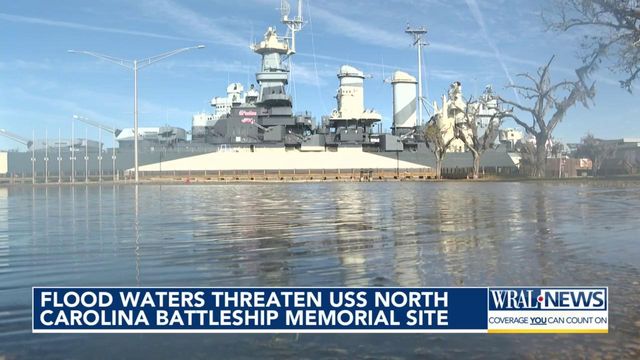Battleship NC begins project to elevate parking lot, protect visitors from rising river
The parking lot at the USS North Carolina Battleship in Wilmington is increasingly being overrun by flood waters. At high tide, water and mud can cover the ground.
It is a mucky mess for guests, which threatens the ability of one of the top tourist attractions in North Carolina to sell tickets and, ultimately, stay open.
The battleship's current captain, Capt. Terry Bragg joined Battleship North Carolina after 30 years in the U.S. Navy. He's been executive director of the USS North Carolina for the past 15, and has seen the flooding problem rise over about a decade.
"We started losing the parking lot for hours at a time," he says.
In 2022, the site saw 200 days of flooding.
Maintenance of the ship, the site and the grounds is funded through ticket sales and donations.
"If I can't sell tickets and I can't have a place for visitors to park, then the battleship, which is independent, could go broke," Bragg says.
High tide flooding, also called "nuisance" or "sunny day" flooding, is happening more often as sea levels rise, according to the National Oceanic and Atmospheric Administration.
Roger Shew, with the University of North Carolina at Wilmington department of earth and ocean sciences, says the battleship's location is especially vulnerable.
"All of Eagle Island (the plot between the Cape Fear and Brunswick rivers where the battleship access is located) is pretty low, so whenever you get the high tides coming up that water can spill out of the river onto the land," he said.
In 2018, the historic site launched the Living with Water project, a plan to turn part of the existing parking lot into wetlands and raise the remaining parking area by up to three feet and give it better drainage.
Bragg showed WRAL News where the "living shoreline" will be.
He says a nature-based mitigation strategy made more sense than a wall.
"Then if we need to change course, add different plant life or raise the elevation, it's a cheap fix, and we don't have to worry about the horrendous infrastructure cost to rebuild another wall."
For Bragg, saving the site is about preserving history.
"The Battleship North Carolina is near and dear to my heart. It is a memorial to the 11,000 North Carolinians who served and died," he said.
Work on the project began Friday morning and is expected to be complete in about eight months.











